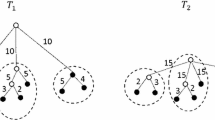Abstract
Given an n-vertex non-negatively real-weighted graph G, whose vertices are partitioned into a set of k clusters, a clustered network design problem on G consists of solving a given network design optimization problem on G, subject to some additional constraints on its clusters. In particular, we focus on the classic problem of designing a single-source shortest-path tree, and we analyse its computational hardness when in a feasible solution each cluster is required to form a subtree. We first study the unweighted case, and prove that the problem is \({\textsf {NP}}\)-hard. However, on the positive side, we show the existence of an approximation algorithm whose quality essentially depends on few parameters, but which remarkably is an O(1)-approximation when the largest out of all the diameters of the clusters is either O(1) or \(\varTheta (n)\). Furthermore, we also show that the problem is fixed-parameter tractable with respect to k or to the number of vertices that belong to clusters of size at least 2. Then, we focus on the weighted case, and show that the problem can be approximated within a tight factor of O(n), and that it is fixed-parameter tractable as well. Finally, we analyse the unweighted single-pair shortest path problem, and we show it is hard to approximate within a (tight) factor of \(n^{1-\epsilon }\), for any \(\epsilon >0\).



Similar content being viewed by others
Notes
Throughout the paper, the notation \(\widetilde{O}\) suppresses factors that are polylogarithmic in n.
The runtime originally given in Björklund et al. (2007) is here restated on our (implicitly assumed) model of computation, namely the standard unit-cost RAM with logarithmic word size, on which the \(O(|X|^2 \cdot 2^{|X|})\) ring operations performed in Björklund et al. (2007) cost \(O(W \cdot |X| \cdot {\text {polylog}}(W,|X|))\) time each. Notice that we are explicitly stating polynomial factors in |X|, i.e., logarithmic factors in \(2^{|X|}\), which are disregarded in Björklund et al. (2007), since they will result in polynomial factors in k in the running time of our FPT algorithm.
The X3C problem remains NP-complete even with this additional assumption, see e.g., problem SP2 in Garey and Johnson (1979).
References
Bao X, Liu Z (2012) An improved approximation algorithm for the clustered traveling salesman problem. Inf Process Lett 112(23):908–910
Bilò D, Grandoni F, Gualà L, Leucci S, Proietti G (2015) Improved purely additive fault-tolerant spanners. In: Proceedings 23rd European symposium on algorithms (ESA), volume 9294 of Lecture notes in computer science. Springer, pp 167–178
Björklund A, Husfeldt T, Kaski P, Koivisto M (2007) Fourier meets möbius: fast subset convolution. In: Proceedings 39th ACM symposium on theory of computing (STOC). ACM, pp 67–74
Byrka J, Grandoni F, Rothvoß T, Sanità L (2013) Steiner tree approximation via iterative randomized rounding. J ACM 60(1):6
Dasgupta S, Papadimitriou CH, Vazirani U (2008) Algorithms, 1st edn. McGraw-Hill Inc, New York
D’Emidio M, Forlizzi L, Frigioni D, Leucci S, Proietti G (2016) On the clustered shortest-path tree problem. In: Proceedings 17th Italian conference on theoretical computer science (ICTCS), volume 1720 of CEUR workshop proceedings, pp 263–268
Fareed MS, Javaid N, Akbar M, Rehman S, Qasim U, Khan ZA (2012) Optimal number of cluster head selection for efficient distribution of sources in WSNs. In: Proceedings seventh international conference on broadband, wireless computing, communication and applications. IEEE, pp 626–631
Feremans C, Labbé M, Laporte G (2003) Generalized network design problems. Eur J Oper Res 148(1):1–13
Garey MR, Johnson DS (1979) Computers and intractability: a guide to the theory of NP-completeness. W. H. Freeman & Co, New York
Garg N, Konjevod G, Ravi R (2000) A polylogarithmic approximation algorithm for the group Steiner tree problem. J Algorithms 37(1):66–84
Guttmann-Beck N, Hassin R, Khuller S, Raghavachari B (2000) Approximation algorithms with bounded performance guarantees for the clustered traveling salesman problem. Algorithmica 28(4):422–437
Halperin E, Krauthgamer R (2003) Polylogarithmic inapproximability. In: Proceedings 35th ACM symposium on theory of computing (STOC), pp 585–594
Lin C, Wu BY (2016) On the minimum routing cost clustered tree problem. J Comb Optim 31(1):1–16
Sevgi C, Kocyigit A (2008) On determining cluster size of randomly deployed heterogeneous WSNs. IEEE Commun Lett 12(4):232–234
Wu BY, Lancia G, Bafna V, Chao K-M, Ravi R, Tang CY (1998) A polynomial time approximation scheme for minimum routing cost spanning trees. In: Proceedings 9th ACM-SIAM symposium on discrete algorithms (SODA), pp 21–32
Wu BY, Lin C (2015) On the clustered Steiner tree problem. J Comb Optim 30(2):370–386
Zou P, Li H, Wang W, Xin C, Zhu B (2018) Finding disjoint dense clubs in a social network. Theor Comput Sci 734:15–23
Author information
Authors and Affiliations
Corresponding author
Additional information
Publisher's Note
Springer Nature remains neutral with regard to jurisdictional claims in published maps and institutional affiliations.
The results presented in this work have been announced in a preliminary form in D’Emidio et al. (2016). This research has partially supported by the Italian National Group for Scientific Computation GNCS-INdAM.
Rights and permissions
About this article
Cite this article
D’Emidio, M., Forlizzi, L., Frigioni, D. et al. Hardness, approximability, and fixed-parameter tractability of the clustered shortest-path tree problem. J Comb Optim 38, 165–184 (2019). https://doi.org/10.1007/s10878-018-00374-x
Published:
Issue Date:
DOI: https://doi.org/10.1007/s10878-018-00374-x




